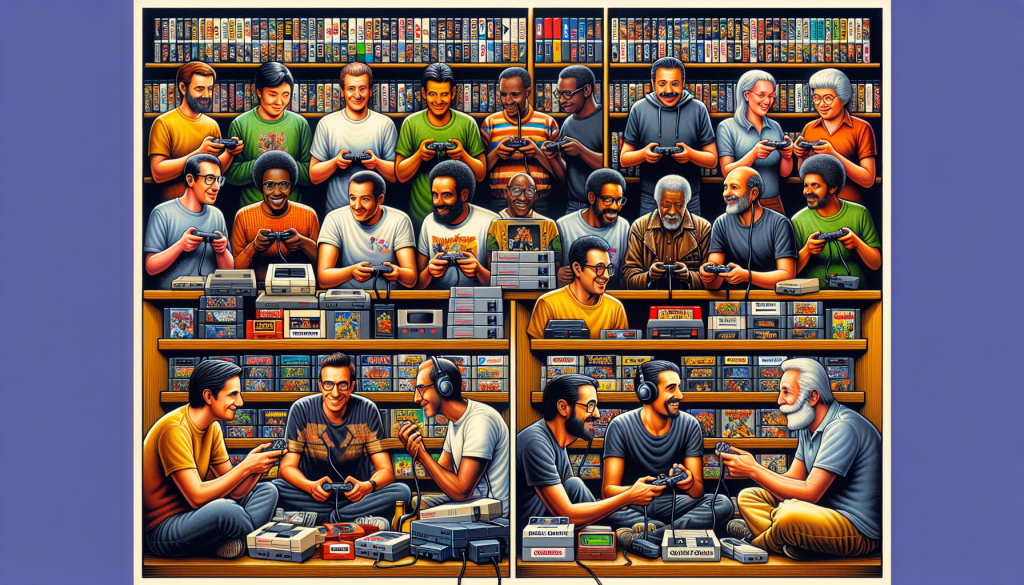Hey there, gaming enthusiasts!
Are you ready to take a trip down memory lane and explore the fascinating history of arcades? Strap yourselves in, because we’re about to embark on a journey through time to discover how these iconic gaming establishments came to be.
The Rise of Arcades: A Historical Overview
Back in the 1970s and 1980s, long before consoles and PC gaming took center stage, arcades were the ultimate gaming hotspots. Picture this: rows upon rows of flashy cabinets, emitting beeps, blips, and colorful lights, all vying for the attention of eager gamers.

It all began with the release of Pong, the first commercially successful arcade game, in 1972. Created by Atari, this simple yet addictive table tennis simulation caused a sensation, igniting the arcade revolution. Suddenly, people of all ages were flocking to arcades, eager to experience the thrill of interactive entertainment.
The popularity of arcades soared throughout the 1980s, with landmark games like Pac-Man, Donkey Kong, and Space Invaders captivating players worldwide. These titles became cultural phenomena, spawning merchandise, cartoons, and even inspiring a hit song or two!
But what made arcades so appealing? For starters, they offered an unmatched social experience. Friends and strangers alike would gather around cabinets, cheering each other on, exchanging tips and tricks, and engaging in friendly competition. Arcades were buzzing with energy and camaraderie, creating a sense of community that is often missing in solitary gaming experiences.
Additionally, arcades provided access to cutting-edge technology. The games boasted eye-catching graphics, innovative control schemes, and immersive sound effects, all of which were far beyond what home consoles could offer at the time. It was a chance to step into a whole new world of interactive entertainment.
As arcades continued to flourish, game developers were spurred to push the boundaries of innovation. They constantly sought new ways to captivate players, leading to the birth of numerous iconic characters and game mechanics that we still cherish today. Without the influence of arcades, the landscape of video game development would be vastly different.
Before we wrap up this part of our journey, let’s not forget about the timeless classics – the games that defined an era. From the mesmerizing mazes of Pac-Man to the barrel-jumping adventures of Donkey Kong, these titles continue to hold a special place in the hearts of gamers old and new.
Stay tuned for the next installment, where we’ll delve into the role of arcades in building gaming communities. Until then, keep your joysticks at the ready and your quarters stacked!
The Impact of Arcades on Video Game Development
Arcades have played a significant role in shaping the world of video games as we know it today. These vibrant, bustling spaces have not only provided endless hours of entertainment but have also had a profound impact on the development of video games. From influencing game design to fostering innovation and competition, arcades have left an indelible mark on the gaming industry. One of the most significant ways in which arcades have influenced video game development is through their emphasis on gameplay mechanics. In arcades, where players are constantly vying for high scores and bragging rights, gameplay needed to be engaging and addictive. This led to the development of games with simple yet challenging mechanics that kept players coming back for more. Classics like Pac-Man, Space Invaders, and Street Fighter are prime examples of games that have stood the test of time due to their intuitive and captivating gameplay. Arcades also served as a breeding ground for innovation in game design. Game developers were constantly striving to create new and exciting experiences to attract players to their cabinets. This led to the introduction of groundbreaking concepts such as multiplayer gaming and immersive environments. Games like Gauntlet, where players could team up and venture through dungeons together, or Star Wars, which utilized vector graphics to transport players into a galaxy far, far away, pushed the boundaries of what was possible in gaming. Furthermore, arcades provided a unique platform for competition and skill development. The competitive nature of arcades encouraged players to hone their skills, learn new strategies, and push the limits of their abilities. This competitive environment not only fueled the desire for high scores but also inspired the birth of professional gaming. Some of today’s most successful esports players, such as Daigo Umehara and Justin Wong, started their careers in the arcades, utilizing their expertise and competitive spirit to achieve greatness. Arcades also played a crucial role in building gaming communities. These vibrant spaces brought people of all backgrounds together, united by their love for gaming. Whether it was gathering around a fighting game cabinet, cheering on a player attempting to break a high score, or simply sharing tips and tricks with fellow enthusiasts, arcades fostered a sense of camaraderie and connection among gamers. Today, the influence of arcades on video game development can still be felt. Many popular gaming franchises that originated in arcades, such as Mortal Kombat and Street Fighter, continue to thrive and evolve, captivating new generations of players. The emphasis on engaging gameplay mechanics, innovation in design, and fostering competitive communities that were born in arcades continues to shape the way games are created and enjoyed. In conclusion, arcades have had a profound impact on video game development. From shaping gameplay mechanics to fostering innovation and competition, arcades have played a vital role in the evolution of gaming. Their legacy lives on in today’s gaming culture, reminding us of the power of immersive experiences and the joy of sharing them with others. So the next time you pick up a controller, take a moment to appreciate the influence of arcades and the lasting impact they have left on the world of gaming.Building Gaming Communities: The Role of Arcades
When we think about gaming communities today, the first things that come to mind are online forums, social media groups, and streaming platforms. But before the rise of the internet, there was another place where gamers gathered to compete, share tips, and form friendships: the arcade.
Arcades were not just a place to play video games; they were a hub for like-minded individuals to connect and bond over their shared love for gaming. The arcade culture of the 80s and 90s played a crucial role in building gaming communities that still thrive to this day.
A Social Gathering Spot
Step into any arcade during its heyday, and you would be greeted by the enthusiastic sounds of coin-operated machines and the cheers of competitive gamers. With rows of colorful cabinets lining the walls, arcades became a social gathering spot for gamers of all ages and skill levels.
Whether you were a seasoned player or a complete newbie, the arcade provided a welcoming environment for everyone. It was a place where you could watch and learn from the pros, challenge your friends to a friendly competition, or strike up a conversation with a fellow gamer about your favorite games and strategies.
Competitive Spirit and Camaraderie
Arcades fostered a sense of healthy competition like no other gaming platform. The thrill of facing off against an opponent side by side, with spectators eagerly watching, created an electric atmosphere that could not be replicated at home.
But it wasn’t just about the competition. Arcades also bred camaraderie among gamers. Strangers would bond over their shared experiences, offering tips and tricks to help each other improve. Friendships were formed, and rivalries were born, all within the walls of the arcade.
Embracing Diversity
Arcades were known for attracting a diverse range of players, breaking down barriers and bringing people from all walks of life together. Regardless of age, gender, or background, everyone was welcome in the arcade community.
This inclusivity and diversity created a rich tapestry of experiences and perspectives. It allowed gamers to learn from one another, gain new insights, and appreciate the different ways people approached games. It was this melting pot of ideas and talents that fueled innovation and pushed the boundaries of gaming.
The Importance of Local Arcades
While online gaming has opened up a whole new world of virtual communities, the local arcade still holds a special place in many gamers’ hearts. These brick-and-mortar establishments serve as physical meeting points, where enthusiasts can gather to celebrate their shared passion.
By visiting local arcades, you not only support small businesses but also contribute to the growth of gaming communities. You have the opportunity to connect with fellow gamers, engage in friendly competition, and create lasting memories that can’t be replicated online.
So, next time you have the chance, step away from your console or computer and visit a local arcade. Immerse yourself in the vibrant atmosphere, challenge yourself against skilled opponents, and connect with the gaming community in a way that only the arcade can offer.












